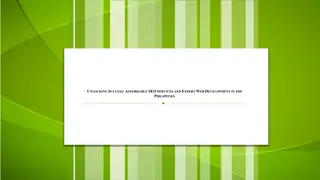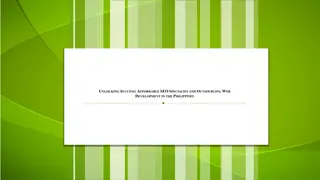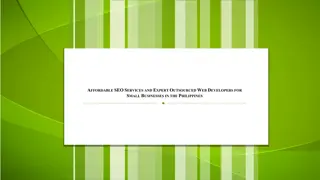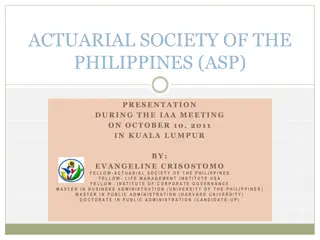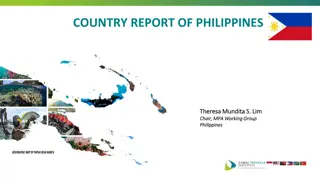Evolution of Science and Technology in the Philippines
This paper explores the history of science and technology in the Philippines, emphasizing the intertwined influence of geography, colonial trade, policies, and socio-cultural factors. It discusses the development of science and technology, highlighting the shift from separate entities to intertwined progress in modern times.
Download Presentation

Please find below an Image/Link to download the presentation.
The content on the website is provided AS IS for your information and personal use only. It may not be sold, licensed, or shared on other websites without obtaining consent from the author. Download presentation by click this link. If you encounter any issues during the download, it is possible that the publisher has removed the file from their server.
E N D
Presentation Transcript
A HISTORY OF SCIENCE AND TECHNOLOGY IN THE PHILIPPINES* Olivia C. Caoili** *Paper prepared for the University of the Philippines Science Research Foundation in connection with its project on "Analysis of Conditions for National Scientific and Technological Self-Reliance: The Philippine Situation," June 1986. **Associate Professor, Department of Political Science, College of Social Sciences and Philosophy. University of the Philippines in Diliman, Quezon City.
Introduction The need to develop a country's science and technology has generally been recognized as one of the imperatives of socioeconomic progress in the contemporary world. This has become a widespread concern of governments especially since the post world war II years(1). Among Third World countries, an important dimension of this concern is the problem of dependence in science and technology as this is closely tied up with the integrity of their political sovereignty and economic self-reliance. There exists a continuing imbalance between scientific and technological development among contemporary states with 98 per cent of all research and development facilities located in developed countries and almost wholly concerned with the latter's problems.(2) Dependence or autonomy in science and technology has been a salient issue in conferences sponsored by the United Nations.(3)
About the organization of this material It is within the above context that this paper attempts to examine the history of science and technology in the Philippines. Rather than focusing simply on a straight chronology of events, it seeks to interpret and analyze the interdependent effects of geography, colonial trade, economic and educational policies and socio-cultural factors in shaping the evolution of present Philippine science and technology.
More about S&T As used in this paper, science is concerned with the systematic understanding and explanation of the laws of nature. Scientific activity centers on research, the end result of which is the discovery or production of new knowledge.(4) This new knowledge may or may not have any direct or immediate application. In comparison, technology has often been understood as the "systematic knowledge of the industrial arts."(5) As this knowledge was implemented by means of techniques, technology has become commonly taken to mean both the knowledge and the means of its utilization, that is, "a body, of knowledge about techniques."(6) Modern technology also involves systematic research but its outcome is more concrete than science, i.e. the production of "a thing, a chemical, a process, something to be bought and sold."(7)
More about S&T In the past, science and technology developed separately, with the latter being largely a product of trial and error in response to a particular human need. In modern times, however, the progress of science and technology have become intimately linked together. Many scientific discoveries have been facilitated by the development of new technology. New scientific knowledge in turn has often led to further refinement of existing technology or the invention of entirely new ones.
Precolonial Science and Technology There is a very little reliable written information about Philippine society, culture and technology before the arrival of the Spaniards in 1521. (8) As such, one has to reconstruct a picture of this past using contemporary archaeological findings, accounts by early traders and foreign travelers, and the narratives about conditions in the archipelago which were written by the first Spanish missionaries and colonial officials. According to these sources, there were numerous, scattered, thriving, relatively self-sufficient and autonomous communities long before the Spaniards arrived. The early Filipinos had attained a generally simple level of technological development, compared with those of the Chinese and Japanese, but this was sufficient for their needs at that period of time.
Precolonial Science and Technology Archaeological findings indicate that modern men (homo sapiens) from the Asian mainland first came over-land and across narrow channels to live in Palawan and Batangas around 50,000 years ago. For about 40,000 years, they made simple tools or weapons of stone flakes but eventually developed techniques for sawing, drilling and polishing hard stones. These Stone Age inhabitants, subsequently formed settlements in the major Philippine islands such as Sulu, Mindanao (Zamboanga, and Davao), Negros, Samar, Luzon (Batangas, Laguna, Rizal, Bulacan and the Cagayan region).
Precolonial Science and Technology By about 3,000 B.C., they were producing adzes ornaments of seashells and pottery of various designs. The manufacture of pottery subsequently became well developed and flourished for about 2,000 years until it came into competition with imported Chinese porcelain. Thus over time pottery making declined. What has survived of this ancient technology is the lowest level, i.e., the present manufacture of the ordinary cooking pot among several local communities.(9) Gradually, the early Filipinos learned to make metal tools and implements -- copper, gold, bronze and, later, iron. The iron age is considered to have lasted from the second or third century B.C. to the tenth century A.D. Excavations of Philippine graves and work sites have yielded iron slags. These suggest that Filipinos during this period engaged in the actual extraction of iron from ore, smelting and refining. But it appears that the iron industry, like the manufacture of pottery, did not survive the competition with imported cast iron from Sarawak and much later, from China.(10)
Precolonial Science and Technology By the first century A.D., Filipinos were weaving cotton smelting iron making pottery glass ornaments engaged in agriculture. Lowland rice was cultivated in diked fields, and in the interior mountain regions as in the Cordillera, in terraced fields which utilized spring water.(11)
Precolonial Science and Technology Filipinos had also learned to build boats for the coastal trade. By the tenth century A.D., this had become a highly developed technology. In fact, the early Spanish chroniclers took note of the refined plank-built warship called caracoa. These boats were well suited for inter-island trade raids. The Spaniards later utilized Filipino expertise in boat-building and seamanship to fight the raiding Dutch, Portuguese, Muslims and the Chinese pirate Limahong as well as to build and man the galleons that sailed to Mexico. (12)
Precolonial Science and Technology By the tenth century A.D., the inhabitants of Butuan were trading with Champa(Vietnam); those of Ma-i (Mindoro) with China. Chinese records with have now been translated contain a lot of references to the Philippines. These indicate that regular trade relations between the two countries had been well established during the tenth to the fifteenth centuries. Archaeological findings (in various parts of the archipelago) of Chinese porcelains made during this period support this contention. From the Sung (960-1278) and Yuan (1260-1368) Dynasties, there are descriptions of trade with the Philippines, and from the Sung and Ming (1360-1644) Dynasties there are notices of Filipino missions to Peking.(13)
Precolonial Science and Technology The most frequently cited Chinese account in Philippine history textbooks is that of Chao Ju-Kua in 1225. He described the communities and trading activities in the islands of Ma-i (Mindoro) and San-hsu (literally three islands which present-day historians think refer to the group of Palawan and Calamian Islands).(14) The people of Ma-i and San-hsu traded: beeswax, cotton, true pearls, tortoise shell, medicinal betelnuts, yu-ta cloth (probably jute or ramie?) and coconut heart mats for Chinese porcelain, iron pots, lead fishnet sinkers, coloredglass beads, iron needles and tin. These were practically the same commodities of trade between the islands and China which the first Spanish colonial officials recorded when they came to the Philippines more than two centuries later.(15)
Precolonial Science and Technology The Filipinos in Mindanao and Sulu traded with Borneo, Malacca and parts of the Malay peninsula. This trade seems to have antedated those with the Chinese. By the time the Spaniards reached the archipelago, these trade relations had been firmly established such that the alliance between the rulers of manila and Brunei had become strengthened by marriage. It was through these contacts that Hindu-Buddhist, Malay-Sanskrit and Arab- Muslim Cultural and technological influences spread to the Philippines. There have also been some references (by early travelers during the precolonial period) to trade relations between Japan and the Philippines. To date however, Philippine historians have not found any prehispanic references to the Philippines in Japanese literature of the period.(16)
Precolonial Science and Technology By the time the Spaniards came to colonies the Philippines in 1565, they found many scattered, autonomous village communities (called barangays) all over the archipelago. These were kinship groups or social units rather than political units. They were essentially subsistence economies producing mainly what they needed.
Precolonial Science and Technology These communities exhibited uneven technological development. Settlements along the coastal areas which had been exposed to foreign trade and cultural contacts such as Manila, Mindoro, Cebu, Southern Mindanao and Sulu, seem to have attained a more sophisticated technology. In 1570, for example, the Spaniards found the town of Mindoro "fortified by a stone wall over fourteen feet thick," and defended by armed Moros -- "bowmen, lancers, and some gunners, linstocks in hand." There were a "large number of culverins" all along the hillside of the town. They found Manila similarly defended by a palisade along its front with pieces of artillery at its gate. The house of Raja Soliman (which was burned down by Spaniards) reportedly contained valuable articles of trade -- "money, copper, iron, porcelain, blankets, wax, cotton and wooden vats full of brandy." Next to his house was a storehouse which contained: much iron and copper; as well as culverins and cannons which had melted. Some small and large cannon had just begun. There were the clay and wax moulds, the largest of which was for a cannon seventeen feet long, resembling a culverin... (17)
Precolonial Science and Technology These reports indicate that the Filipinos in Manila had learned to make and use modern artillery. The Spanish colonizers noted that all over the islands, Filipinos were growing rice, vegetables and cotton; raising swine, goats and fowls; making wine, vinegar and salt; weaving cloth and producing beeswax and honey. The Filipinos were also mining gold in such places as Panay, Mindoro and Bicol. They wore colorful clothes, made their own gold jewelry and even filled their teeth with gold. Their houses were made of wood or bamboo and nipa. They had their own system of writing,(18) and weights and measures. Some communities had become renowned for their plank-built boats. They had no calendar but counted the years by moons and from one harvest to another.
Precolonial Science and Technology On the whole, the pre-colonial Filipinos were still highly superstitious. The Spaniards found no temples or places of worship. Although the Filipinos knew how to read and write in their own system, this was mainly used for messages and letters. They seem not to have developed a written literary tradition at that time.(20) This would have led to a more systematic accumulation and dissemination of knowledge, a condition that is necessary for the development of science and technology. Because of the abundance of natural resources, a benign environment and generally sparse population, there seemed to have been little pressure for invention and innovation among the early Filipinos. As governor Francisco deSande observed in 1575, the Filipinos do not understand any kind of work, unless it be to do something actually necessary -- such as to build their houses, which are made of stakes after their fashion; to fish, according to their method; to row, and perform the duties of sailors; and to cultivate the land... (21)
Precolonial Science and Technology In the interior and mountain settlements, many Filipinos were still living as hunters. They gathered forest products to trade with the lowland and coastal settlements. But they also made "iron lance-points, daggers and certain small tools used in transplanting."(19)
Developments in Science and Technology During the Spanish Regime The beginnings of modern science and technology in the Philippines can be traced to the Spanish regime. The Spaniards established schools, hospitals and started scientific research and these had important consequences for the rise of the country's professions. But the direction and pace of development of science and technology were greatly shaped by the role of the religious orders in the conquest and colonization of the archipelago and by economic and trade adopted by the colonial government.
Developments in Science and Technology During the Spanish Regime The beginnings of modern science and technology in the Philippines can be traced to the Spanish regime. The Spaniards established schools, hospitals and started scientific research and these had important consequences for the rise of the country's professions. But the direction and pace of development of science and technology were greatly shaped by the role of the religious orders in the conquest and colonization of the archipelago and by economic and trade adopted by the colonial government. The interaction of these forces and the resulting socio-economic and political changes must,therefore, be analyzed in presenting a history of science and technology in the Philippines.
Developments in Science and Technology During the Spanish Regime Spanish conquest and the colonization of the archipelago was greatly facilitated by the adoption of an essentially religious strategy which had earlier been successfully used in Latin America. Known as reduccion, it required the consolidation of the far-flung, scattered barangay communities into fewer, larger and more compact settlements within the hearing distance of the church bells. This was a necessary response to the initial shortage of Spanish missionaries in the Philippines. This policy was carried out by a combination of religious conversion and military force.
Developments in Science and Technology During the Spanish Regime The net result of reduccion was the creation of towns and the foundation of the present system of local government. The precolonial ruling class, the datus and their hereditary successors, were adopted by the Spanish colonial government into this new system to serve as the heads of the lowest level of local government; i.e. as cabezas de barangay. The colonial authorities found the new set-up expeditious for establishing centralized political control over the archipelago -- for the imposition and collection of the tribute tax, enforcement of compulsory labor services among the native Filipinos, and implementation of the compulsory sale of local products to the government.
Developments in Science and Technology During the Spanish Regime The Filipinos naturally resisted reduccion as it took them away from their rice fields, the streams and the forests which were their traditional sources of livelihood and also subjected them to the onerous economic exactions by the colonial government. Thus the first century of Spanish rule brought about serious socio-economic dislocation and a decline kin agricultural production and traditional crafts in many places. In the region surrounding the walled city of Manila, Filipinos migrated from their barangays to the city in order to serve in the convents and thus avoid the compulsory labor services in the shipyards and forests.(22) Over the centuries, this population movement would greatly contribute to the congestion of Manila and its suburbs.
Developments in Science and Technology During the Spanish Regime The religious orders likewise played a major role in the establishment of the colonialeducational system in the Philippines. They also influenced the development of technology and promotion of scientific research. hence, these roles must next be examined.
Developments in Science and Technology During the Spanish Regime Various decrees were issued in Spain calling for the establishment of a school system in the colony but these were not effectively carried out.(23) Primary instruction during the Spanish regime was generally taken care of by the missionaries and parish priests in the villages and towns. Owing to the dearth of qualified teachers, textbooks and other instructional materials, primary instruction was mainly religious education.
Developments in Science and Technology During the Spanish Regime Higher education was provided by schools set up by the different religious orders in the urban centers, most of them in Manila. For example, the Jesuits founded in Cebu City the Colegio de San Ildefonso (1595) and in Manila, the Colegio de San Ignacio (1595), the Colegio de San Jose (1601) and the Ateneo de Manila (1859). The Dominicans had the Colegio de San Juan de Letran (1640) in Manila.(24) Access to these schools was, however, limited to the elite of the colonial society -- the European-born and local Spaniards, the mestizos and a few native Filipinos. Courses leading to the B.A. degree, Bachiller en Artes, were given which by the nineteenth century included science subjects such as physics, chemistry, natural historyand mathematics.(25)
Developments in Science and Technology During the Spanish Regime On the whole, however, higher education was pursued for the priesthood or for clerical positions in the colonial administration. It was only during the latter part of the nineteenth century that technical/vocational schools were established by the Spaniards.(26)
Developments in Science and Technology During the Spanish Regime Throughout the Spanish regime, the royal and pontifical University of Santo Tomas remained as the highest institution of learning.(27) Run by the Dominicans, it was established as a college in 1611 by Fray Miguel de Benavides. it initially granted degrees in theology, philosophy and humanities. (28) During the 18thcentury, the faculty of jurisprudence and canonical law was established. In 1871, the schools of medicine and pharmacy were opened. From 1871 to 1886, the University of Snato Tomas granted the degree of Licenciado en Medicina to 62 graduates.(29) For the doctorate degree in medicine, at least an additonal year of study was required at the Universidad Central de Madrid in Spain.
Developments in Science and Technology During the Spanish Regime Throughout the Spanish regime, the royal and pontifical University of Santo Tomas remained as the highest institution of learning.(27) Run by the Dominicans, it was established as a college in 1611 by Fray Miguel de Benavides. it initially granted degrees in theology, philosophy and humanities. (28) During the 18thcentury, the faculty of jurisprudence and canonical law was established. In 1871, the schools of medicine and pharmacy were opened. From 1871 to 1886, the University of Snato Tomas granted the degree of Licenciado en Medicina to 62 graduates.(29) For the doctorate degree in medicine, at least an additonal year of study was required at the Universidad Central de Madrid in Spain.
Developments in Science and Technology During the Spanish Regime The study of pharmacy consisted of a preparatory course with subjects in natural history and general chemistry and five years of studies in subjects such as pharmaceutical operations at the school of pharmacy. At the end of this period of the degree of Bachiller en Farmacia was granted. The degree of licentiate in pharmacy, which was equivalent to a master's degree, was granted after two years of practice in a pharmacy, one lof which could be taken simultaneously with the academic courses after the second year course of study. In 1876, the university granted the bachelor's degree in pharmacy to its first six graduates in the school of pharmacy. Among them was Leon Ma. Guerrero, who is usually referred to as the "Father of Philippine Pharmacy" becuase of his extensive work on the medicinal plants of the Philippines and their uses.(30) The total number of graduates in pharmacy during the Spanish period was 164. (31).
Developments in Science and Technology During the Spanish Regime There were no schools offering engineering at that time. The few who studied engineering had to go to Europe. There was a Nautical School created on 1 January 1820 which offered a four- year course of study (for the profession of pilot of merchant marine) that included subjects as arithmetic, algebra, geometry, trigonometry, physics, hydrography, meteorology, navigation and pilotage.(32) A School of Commercial Accounting and a School of French and English Languages were established in 1839.(33)
Developments in Science and Technology During the Spanish Regime There were no schools offering engineering at that time. The few who studied engineering had to go to Europe. There was a Nautical School created on 1 January 1820 which offered a four- year course of study (for the profession of pilot of merchant marine) that included subjects as arithmetic, algebra, geometry, trigonometry, physics, hydrography, meteorology, navigation and pilotage.(32) A School of Commercial Accounting and a School of French and English Languages were established in 1839.(33)
Developments in Science and Technology During the Spanish Regime In 1887, the Manila School of Agriculture was created by royal decree but it was ableto open only in July 1889. The School was designed to provide theoretical and practicaleducation of skilled farmers and overseers and to promote agricultural development in thePhilippines by means of observation, experiment and investigation. Agricultural stations were also established in Isabela, Ilocos, Albay, Cebu, Iloilo, Leyte and parts of Mindanao. The professors in the School were agricultural engineers. The School was financed by the government but it appears that its direction was also left to the priests. The certificates of completion of the course were awarded by the university of Santo Tomas or the Ateneo Municipal. It seems that the School was not successful as Filipinos did not show muchinclination for industrial pursuits.(34)
Developments in Science and Technology During the Spanish Regime In 1863, the colonial authorities issued a royal decree designed to reform the existing educational system in the country. It provided for the establishment of a system of elementary, secondary and collegiate schools, teacher- training schools, and called forgovernment supervision of these schools. The full implementation of this decree, however, was interrupted by the coming of the Americans in 1898.
Developments in Science and Technology During the Spanish Regime Higher education during the Spanish regime was generally viewed with suspicion and feared by the colonial authorities as encouraging conspiracy and rebellion among the native Filipinos. For this reason, only the more daring and persevering students were able toundertake advantaged studies. The attitude of the Spanish friars towards the study of thesciences and medicine was even more discouraging. As one Rector of the Univesity of Santo Tomas in the 1960s said: "Medicine and the natural sciences are materialistic and impious studies."(35)
Developments in Science and Technology During the Spanish Regime Higher education during the Spanish regime was generally viewed with suspicion and feared by the colonial authorities as encouraging conspiracy and rebellion among the native Filipinos. For this reason, only the more daring and persevering students were able toundertake advantaged studies. The attitude of the Spanish friars towards the study of thesciences and medicine was even more discouraging. As one Rector of the Univesity of Santo Tomas in the 1960s said: "Medicine and the natural sciences are materialistic and impious studies."(35)
Developments in Science and Technology During the Spanish Regime It was not surprising, therefore, that few Filipinos ventured to study these disciplines. Those who did were poorly trained when compared with those who had gone to European universities. Science courses at the University of Santo Tomas were taught by the lecture/recitation method. Laboratory equipment was limited and only displayed for visitors to see. There was little or no training in scientific research.(36) Sir John Bowring, the British Governor of Hongkong who made an official visit to the Philippines in the 1850s wrote: Public instruction is in an unsatisfactory state in the Philippines--the provisions are little changed from those of the monkish ages.
Developments in Science and Technology During the Spanish Regime In the University of Santo Tomas... no attention is given to the natural sciences... nor have anyof the educational reforms which have penetrated most of the colleges of Europe and America found their way to the Philippines.(37) In spite of the small number of Filipino graduates from the UST in medicine and the sciences they still faced the problem of unemployment. This was because the colonial government preferred to appoint Spanish and other European-trained professionals to available positions in the archipelago.(38) Many of these graduates later joined the revolutionary movement against Spain.
Developments in Science and Technology During the Spanish Regime With the opening of the Suez Canal in 1869 and the consequent ease in travel andcommunications that it brought about, the liberal ideas and scientific knowledge of the West also reached the Philippines. The prosperity that resulted from increased commerce between the Philippines and the rest of the world enabled Filipino students to go to Europe for professional advanced studies. These included Jose Rizal who was able to pursue studies in Medicine and specialize in ophthalmology in Spain and Germany; Graciano Apacible who studied medicine in Madrid; Antonio Luna who obtained his Ph.D. in pharmacy in Madrid and later worked with renowned scientists in Ghent and Paris; (39) Jose Alejandrino who took up engineering in Belgium, and others. It was this group of students which set up the Propaganda Movement in Europe that eventually led to the Philippine revolution against Spain.
Developments in Science and Technology During the Spanish Regime The religious orders provided most of the teaching force and institutions of learning in the colony. This was similar to the situation that had earlier prevailed in Europe (where they had come from) during the medieval ages. Inevitably, members of the religious orders also took the lead in technological innovation and scientific research. This involvement invariably arose from their need to provide for basic necessities as they went around the archipelago to perform their missionary work of propagating the Catholic faith and to finance the colleges, hospitals and orphanages that they had established.
Developments in Science and Technology During the Spanish Regime The Spaniards introduced the technology of town planning and building with stones, brick and tiles. In may places, the religious (such as Bishop Salazar in Manila) personally led in these undertakings.(40) Because of the lack of skilled Filipinos in these occupations, the Spaniards had to import Chinese master builders, artisans and masons. The native Filipinos were drafted, through the institution of compulsory labor services, to work on these projects. In this manner, the construction of the walls of Manila, its churches, convents, hospitals, schools and public buildings were completed by the seventeenth century.(41)
Developments in Science and Technology During the Spanish Regime The Spaniards introduced the technology of town planning and building with stones, brick and tiles. In may places, the religious (such as Bishop Salazar in Manila) personally led in these undertakings.(40) Because of the lack of skilled Filipinos in these occupations, the Spaniards had to import Chinese master builders, artisans and masons. The native Filipinos were drafted, through the institution of compulsory labor services, to work on these projects. In this manner, the construction of the walls of Manila, its churches, convents, hospitals, schools and public buildings were completed by the seventeenth century.(41)
Developments in Science and Technology During the Spanish Regime Towards the end of the sixteenth century, the religious orders had established several charity hospitals in the archipelago and in fact provided the bulk of this public service. These hospitals became the setting for rudimentary scientific work during the Spanish regime long before the establishment of the University of Santo Tomas (UST) college of medicine. Research in these institutions were confined to pharmacy and medicine and concentrated on the problems of infections diseases, their causes and possible remedies.(42) Several Spanish missionaries observed, catalogued and wrote about Philippine plants, particularly those with medicinal properties. The most notable of these was Father Fernando de Sta. Maria's annual de Medicinas Caseras published in 1763 which was so in demand that it had undergone several editions by 1885.(43)
Developments in Science and Technology During the Spanish Regime By the second half of the nineteenth century, studies of infectious diseases such as smallpox,(44) cholera, bubonic plague, dysentery, leprosy and malaria were intensified with the participation of graduates of medicine and pharmacy from UST.(45) At this time, native Filipinos began to participate in scientific research. In 1887, the Laboratorio Municipal de Ciudad de Manila was created by decree. Its main functions were to conduct biochemical analyses for public health and to undertake specimen examinations for clinical and medico-legal cases. It had a publication called Cronica de Ciencias Medicas de Filipinas showing scientific studies being done during that time.(46)
Developments in Science and Technology During the Spanish Regime There was very little development in Philippine agriculture and industry during the first two centuries of Spanish rule. This was largely due to the dependence of the Spanish colonizers on the profits from the Galleon or Manila-Acapulco trade, which lasted from 1565 to 1813. It was actually based on the trade with China which antedated Spanish rule.(47) The galleons brought to Latin America Chinese goods -- silk and other cloths, porcelain and the like -- and brought back to Manila Mexican silver. When the Spanish and Portuguese thrones were united from 1581 to 1640, goods brought to Manila by ships from Japan and Portuguese ships from Siam, India, Malacca, Borneo and Cambodia were also carried by the galleons to Mexico.(48) Duringthe this time, Manila prospered as the entrepot of the Orient.
Developments in Science and Technology During the Spanish Regime There was very little development in Philippine agriculture and industry during the first two centuries of Spanish rule. This was largely due to the dependence of the Spanish colonizers on the profits from the Galleon or Manila-Acapulco trade, which lasted from 1565 to 1813. It was actually based on the trade with China which antedated Spanish rule.(47) The galleons brought to Latin America Chinese goods -- silk and other cloths, porcelain and the like -- and brought back to Manila Mexican silver. When the Spanish and Portuguese thrones were united from 1581 to 1640, goods brought to Manila by ships from Japan and Portuguese ships from Siam, India, Malacca, Borneo and Cambodia were also carried by the galleons to Mexico.(48) Duringthe this time, Manila prospered as the entrepot of the Orient.
Developments in Science and Technology During the Spanish Regime The Filipinos hardly benefited from the Galleon trade. Direct participation in the trade was limited to Spanish inhabitants of Manila who were given shares of lading space in the galleons. Many of them simply speculated on these trading rights and lived off on their profits. It was the Chinese who profited most from the trade. They acted as the trade's packers, middlemen, retailers and also provided services and other skills which the Spanish community in Intramuros needed.(49)
Developments in Science and Technology During the Spanish Regime Spanish preoccupation with the Manila Galleon eventually led to the neglect of agriculture and mining and the decline of native handicrafts and industries in the Philippines. The deleterious effects of the trade on the archipelago's domestic economy had been pointed out by some Spanish officials as early as 1592.(50) But this seems to have been largely ignored by colonial policy-makers. Only the local shipbuilding industry continued to prosper because of necessity -- to build the galleons and other ships required for internal commerce and the defense of the archipelago. This had become quite well developed according to a French visitor in the nineteenth century. He observed: In many provinces shipbuilding is entirely in the hands of the natives. The excellence of their work is proof that they are perfectly capable of undertaking the study of abstruse sciences and that mathematical equations are by no means beyond their comprehension.... (51)
Developments in Science and Technology During the Spanish Regime Agricultural development was left to the resident Chinese and the Spanish friars. The latter saw in the cultivation of their large estates around Manila a steady source of financial support for their churches, colleges, hospitals and orphanages in Intramuros. The friar estates profited from the expanding domestic food market as a result of the population growth of Manila and its suburbs.(52) But the friars contribution in the development of existing agricultural technology was more of quantitative than qualitative in nature.(53) The profitability of their estates was largely derived from the intensive exploitation of native technology and their free compulsory personal services.
Developments in Science and Technology During the Spanish Regime Successive shipwrecks of and piratical attacks on the galleons to Mexico led to declining profits from the trade and triggered an economic depression in Manila during the latter part of the seventeenth century.(54) This situation was aggravated by increasing restrictions on the goods carried by the Manila Galleon as a consequence of opposition coming from Andalusion merchants and mercantilists in Spain.

















